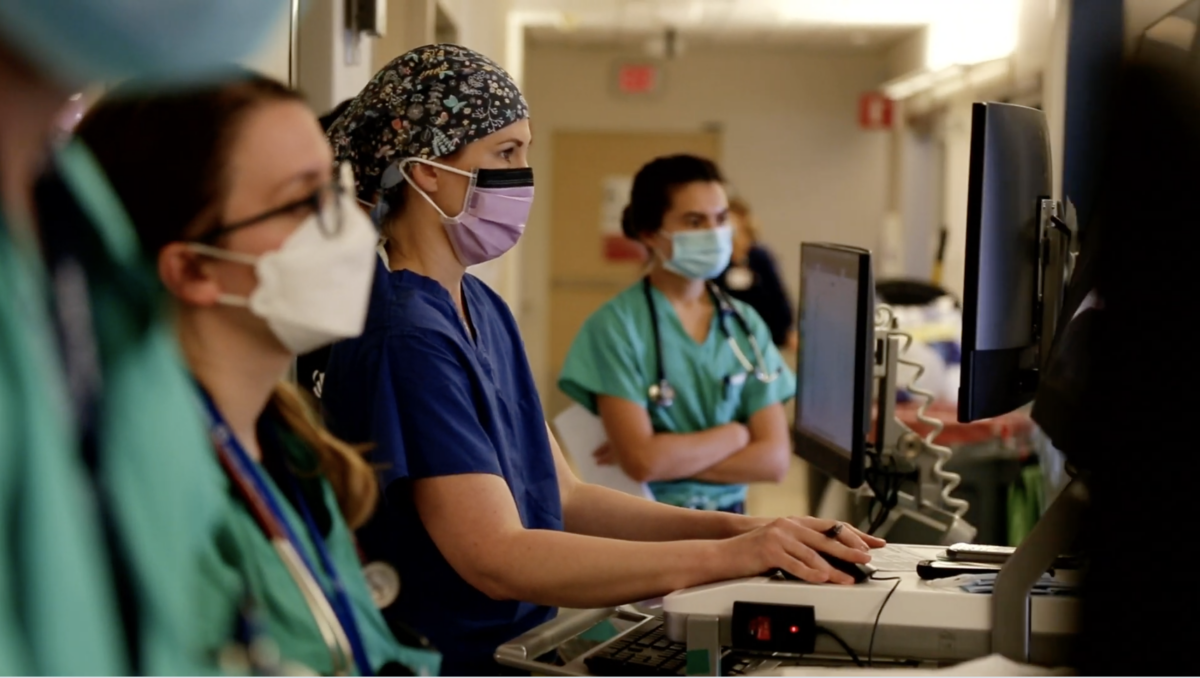
Medical staff at the Johns Hopkins Hospital in Baltimore, Maryland, use TIMS to log audio interviews with patients’ loved ones. Photo: Johns Hopkins Medicine
[Episcopal News Service] Amid all the bodily suffering that hospital workers have seen during the COVID-19 pandemic, Elizabeth Tracey was bothered by another kind of suffering: the dehumanization of care for patients who were intubated and could not speak. Wanting to restore a personal connection between patients and medical staff, she developed an audio system that helps doctors and nurses get to know their patients through the voices of their loved ones.
Even before the pandemic, Tracey – an Episcopalian and lay chaplain at the Johns Hopkins Hospital in Baltimore, Maryland – had been witnessing burnout and frustration among doctors and nurses. Burdened with growing workloads and dealing increasingly with computerized processes, many medical workers were feeling demoralized and disconnected from their patients.
COVID-19 dramatically escalated that phenomenon. Hospital staff have been stretched to their limits, treating unprecedented numbers of patients who are on ventilators and unable to speak. On top of that, the relatives and friends who normally would communicate on behalf of nonverbal patients and give doctors personal insights have been unable to visit for much of the pandemic.
A conversation with a critical care physician in Johns Hopkins’ medical intensive care unit in April 2020 impressed upon Tracey the gravity of this particular aspect of the pandemic.
“All of my patients are intubated, sedated and often prone, and there’s no family telling me their story. I have no idea who they are,” Tracey recalled him saying.
Other doctors and nurses told her the same thing. The lack of personal connection not only contributed to their sense of dehumanization in medicine, but also made it harder to make the right decisions. Getting some sense of the patient’s personality and lifestyle can help doctors determine appropriate care and avoid putting the person through unnecessary procedures.
“I told him I could reach out to the designated contact person listed in patients’ medical charts and find out a bit about them,” she recalled.
That conversation was the genesis of the program now known as This Is My Story, or TIMS. Tracey and other hospital staff members begin by identifying patients who can’t speak – because of intubation or another reason – and who are expected to stay in the hospital longer than three days. She calls their listed contacts and has 10- to 20-minute recorded conversations, asking questions from open-ended to specific. To get the conversation going on a light note, she often asks the relative or friend whether the patient has any pets.
“Most people really love their dogs or other pets and are happy to describe their wonderful qualities, so it helps begin the conversation, usually on a very positive note,” Tracey told Episcopal News Service.
She asks about personality traits, relationships, hobbies, even favorite foods. Then she’ll ask the friends or family members what they would like to say to the patient and what they’d like the medical team to know. She edits the interview down to about 2 minutes and embeds the audio file in the patient’s electronic record so any member of the care team can listen to it.

Elizabeth Tracey, director of Johns Hopkins Medicine Health Newsfeed and chaplain for special ministries at the Johns Hopkins Hospital. Photo: Johns Hopkins Medicine
Tracey, a member of St. James Episcopal Church in Monkton, Maryland, has worked as a broadcast journalist for decades and is the director of Health Newsfeed, a brief daily podcast from Johns Hopkins Medicine that’s syndicated on national radio stations.
“Clearly this helped me a lot in creating TIMS, as I was already very familiar with the format of brief, informative audio,” she told ENS. “Audio files work really well because the clinician can multitask while listening. They can chart, for example, while they hear the patient’s story. Clinicians are already deluged with text-based material.”
Despite some initial skepticism, doctors and nurses have responded positively to TIMS. One doctor, who at first wasn’t convinced it would have any impact, agreed to try it with his patients, and within a few days, he was requesting it for all his eligible patients, Tracey said. Nurses have told her they feel more connected to the patients after listening to the clips, sometimes discovering things they have in common, and giving them something to talk about with their conscious patients, even if they can’t reply with anything more than a smile.
“Sometimes listening to a file brings a tear to someone’s eyes, because they’re so raw and human,” one nurse told Tracey.
The TIMS program has taken on a life of its own, with the help of a $50,000 grant from Johns Hopkins. The chaplaincy department has expanded the program to other units and hospitals in the Johns Hopkins system, and it is now available in languages other than English. Chaplains – including those doing clinical pastoral education training – do the phone interviews, and medical students help edit them down.
Although more family and friends are able to visit in person now, TIMS still serves a valuable function, Tracey said.
“Visitor restrictions are relaxed a bit, relative to how they were when we had a lot of acute COVID in the hospital, but TIMS is still very useful since even when loved ones are present. They don’t want to be telling the patient’s story again and again,” she told ENS, “and the hospital operates 24/7, so other shifts also get a chance to learn about the patient.”
Initially developed with intubated critical COVID-19 patients in mind, TIMS is now used for a variety of patients, from an elderly woman on a ventilator dying of COVID-19 to a middle-aged man recovering from a risky liver transplant to a 33-year-old with cerebral palsy experiencing respiratory trouble. Those who recover are often comforted to learn that their medical team knows more about them than just a name and a diagnosis, Tracey said.
For Tracey, TIMS was an example of one concrete way to improve medical care during a time of so much suffering and uncertainty: by making sure the human connection between caregiver and patient was not lost.
“Watching the everyday heroism of the medical staff, I hope and pray that TIMS files will help support them,” she said.
– Egan Millard is an assistant editor and reporter for Episcopal News Service. He can be reached at emillard@episcopalchurch.org.
"who" - Google News
September 10, 2021 at 03:46AM
https://ift.tt/3jY7Z0X
Hospital chaplain develops system that helps loved ones speak for patients who can't - Episcopal News Service
"who" - Google News
https://ift.tt/36dvnyn
https://ift.tt/35spnC7
Bagikan Berita Ini















0 Response to "Hospital chaplain develops system that helps loved ones speak for patients who can't - Episcopal News Service"
Post a Comment